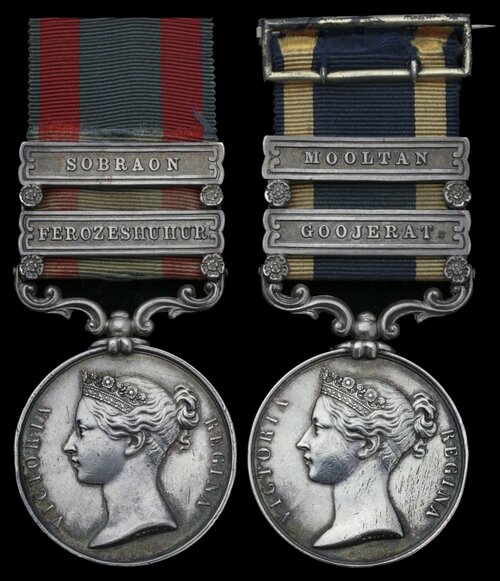
Auction: 22001 - Orders, Decorations and Medals
Lot: 482
(x) The impressive 'Sikh Wars' pair to Captain M. Mackenzie, 1st Brigade, Bengal Horse Artillery, who served under Whish at the Siege of Mooltan and later died of wounds received before Delhi in October 1857
Sutlej, for Moodkee, 2 clasps, Sobraon, Ferozeshuhur (Brevet Capt. M: McKenzie 1st Brigade H: Ay.); Punjab, 2 clasps, Mooltan, Goojerat (Captn. M. Mackenzie, Commg. 4th Tp. 1st Bde. H. Arty.), very fine (2)
Murray Mackenzie was born in Middlesex in 1814, the son of John and Helen Mackenzie. He joined the Bengal Horse Artillery as a Cadet in 1828. Thanks to the reforms of Major-General Sir William Whish (see Spink, Lot 549, April 2018), this elite corps, with its striking uniforms, was arguably the most innovative and successful artillery arm in the world.
After marrying Emily Watson at Calcutta, Mackenzie served as a Captain with the 1st Brigade, Bengal Horse Artillery in the Sutlej Campaign of 1845-46 (also known as the First Sikh War). The River Sutlej separated British India from the Sikh Empire, with its highly-trained 'Khalsa' Army of some 40,000 men. The British force sent to defeat this army was led by Sir Hugh Gough, a grizzled Peninsular veteran who preferred cold steel to long artillery duels. The battles of Ferozeshuhur and Sobraon were bloody affairs in which the infantry suffered badly, but following these victories the Sikhs sued for peace.
When hostilities resumed, Mackenzie served under Whish at the siege of Mooltan, from September 1848 to January 1849. Mooltan was an enormous citadel in the southern Punjab, whose walls had even defied Alexander the Great. In the early stages of the siege, Whish lacked heavy guns and was forced to withdraw towards Bombay in the hope of reinforcement. A brilliant rearguard action was fought at Al Suraj Khund on 23 September, in which the Bengal Horse Artillery protected Whish's flanks by firing canister into the Sikh cavalry. Having received siege guns from Bombay, Whish invested Mooltan on 7 November and finally captured it on 22 January 1849.
While the Siege of Mooltan was underway, Sir Hugh Gough had marched into the northern Punjab with the rest of the British force, making contact with a large Sikh army 70 miles northwest of Lahore. To Whish's great credit, instead of waiting for orders, Whish left a brigade to hold Mooltan and marched the rest of his army some 450 miles to support Gough. Instead of simply joining Gough's army, Whish seized the forts at Wazirabad on 11 February, effectively trapping the Sikhs on the open plan of Goojerat where they could be decimated by the Bengal Horse Artillery. The final victory on 21 February can be attributed to these artillerymen - including Mackenzie - who broke enemy formations before they had a chance to respond.
Captain Mackenzie went on to serve with the 1st Brigade, Bengal Horse Artillery at the Siege of Delhi during the Indian Mutiny. His old command, the 4th (Native) Troop, had actually mutinied at Neemuch in Gwalior, and had to be reformed using European recruits. Rising to Brevet Lieutenant-Colonel, Mackenzie was wounded on 2 July 1857, when the British force under General Barnard was fighting for its life on the ridge before Delhi. He died of wounds received at Delhi on 5 October 1857, and is buried at Simla New Cemetery. He was entitled to an Indian Mutiny Medal with 'Delhi' clasp.
For the recipient's miniature dress medals, see Lot 505.
Subject to 5% tax on Hammer Price in addition to 20% VAT on Buyer’s Premium.
Sold for
£3,200
Starting price
£1200




